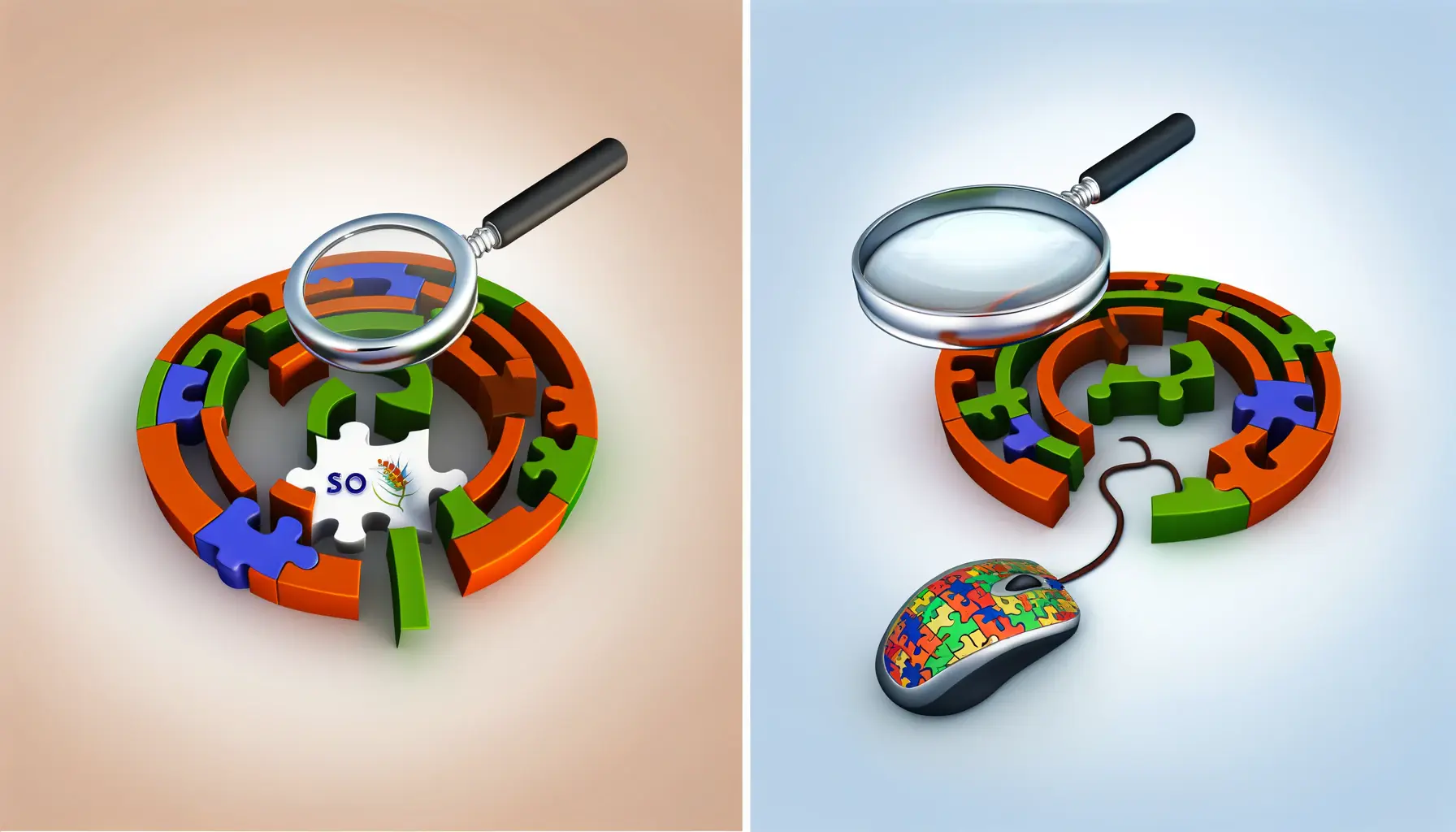Endless scrolling, a feature now ubiquitous across various digital platforms, has revolutionized the way users interact with content online.
This continuous flow of information, while enhancing user experience, presents unique challenges and opportunities in the realm of Search Engine Optimization (SEO).
As search engines evolve to accommodate this trend, understanding and adapting to these changes becomes crucial for SEO strategists and webmasters.
The concept of endless scrolling, where content loads dynamically as the user scrolls down, has altered the traditional structure of web pages.
This shift has significant implications for how search engines index and rank content, necessitating a reevaluation of SEO strategies.
In this comprehensive exploration, we delve into the intricacies of optimizing for endless scrolling, ensuring that your content not only reaches your audience but also engages and retains their attention in this ever-evolving digital landscape.
- Understanding Endless Scrolling and Its Impact on SEO
- Best Practices for SEO in an Endless Scrolling Environment
- Advanced SEO Techniques for Endless Scrolling Pages
- Content Strategy for Endless Scrolling SEO
- Measuring and Analyzing SEO Performance on Endless Scrolling Pages
- Challenges and Solutions in SEO for Endless Scrolling
- Future Trends and Predictions in SEO for Endless Scrolling
- Embracing the Future of SEO in the Era of Endless Scrolling
- FAQs on SEO for Endless Scrolling
Understanding Endless Scrolling and Its Impact on SEO
Endless scrolling, often referred to as infinite scrolling, is a web design technique where content continuously loads as users scroll down the page.
This approach eliminates the need for pagination and provides a seamless browsing experience.
However, it introduces complexities in how search engines index and understand content.
Traditional SEO practices, which relied heavily on the structured format of paginated pages, must now adapt to this fluid content presentation.
One of the primary challenges with endless scrolling is ensuring that all content is accessible to search engine crawlers.
Unlike human users, crawlers may not automatically load content that appears beyond the initial viewport.
This can lead to significant portions of a website remaining unindexed and, consequently, invisible in search engine results pages (SERPs).
To counter this, SEO professionals must employ innovative techniques to make their continuously loading content crawler-friendly.
Adapting Website Structure for Crawlers
Adapting a website’s structure to accommodate endless scrolling while remaining SEO-friendly involves several technical considerations.
Firstly, implementing a system where content is divided into discrete, crawlable segments is essential.
These segments, often referred to as component pages, can be indexed individually by search engines, ensuring that all content is discoverable.
Another critical aspect is the use of ‘pushState’ and ‘replaceState’ methods in JavaScript.
These methods allow for the dynamic updating of URLs as users scroll through content.
This not only aids in tracking user engagement but also ensures that each segment of the endlessly scrolling page has a unique URL, which is crucial for indexing purposes.
Key Point: Optimizing for endless scrolling requires a balance between user experience and technical SEO. Ensuring that all content is accessible to search engine crawlers is paramount for effective indexing and visibility in SERPs.
Best Practices for SEO in an Endless Scrolling Environment
Adapting to the endless scrolling format requires a strategic approach to SEO.
Here are some best practices to ensure that your content is both user-friendly and search engine optimized in an endless scrolling context:
Optimizing Page Load Performance
One of the key challenges with endless scrolling is maintaining optimal page load performance.
As more content loads, it can potentially slow down the website, negatively impacting both user experience and SEO rankings.
To address this:
- Implement lazy loading: Load images and content only as they come into the user’s viewport. This reduces initial page load time and improves overall performance.
- Optimize images and multimedia: Compress and resize images, and use modern formats like WebP to enhance loading speed without compromising quality.
- Minimize JavaScript and CSS: Reduce the size of these files and defer non-essential scripts to decrease loading times.
Ensuring Content Accessibility for Crawlers
Ensuring that search engine crawlers can access and index all content in an endless scrolling setup is crucial.
To achieve this:
- Use pagination elements in the HTML structure: Even with endless scrolling, include pagination tags to help crawlers understand the content structure.
- Provide a sitemap: A well-structured sitemap can guide search engines to all available content, especially the deeper layers not immediately visible.
- Implement crawlable AJAX: Use techniques like progressive enhancement to ensure content loaded via AJAX is accessible to crawlers.
Enhancing User Engagement
While SEO focuses on search engines, user engagement remains a critical factor.
Engaged users signal content relevance and quality to search engines.
To enhance user engagement:
- Create compelling and relevant content: Ensure that the content is valuable and engaging to encourage users to keep scrolling.
- Optimize for mobile users: Since endless scrolling is particularly popular on mobile devices, ensure your site is fully responsive and mobile-friendly.
- Use clear and descriptive headings: Organize content with clear headings to help users navigate and find relevant information easily.
Note: While endless scrolling can enhance user experience, it’s essential to balance this with the technical aspects of SEO to ensure content visibility and accessibility.
Advanced SEO Techniques for Endless Scrolling Pages
To further refine your SEO strategy for endless scrolling pages, it’s important to delve into more advanced techniques.
These methods not only improve crawlability but also enhance the overall user experience, contributing to higher search rankings and better user engagement.
Utilizing Progressive Web App (PWA) Features
Progressive Web Apps offer an advanced approach to handling endless scrolling by combining the best of web and mobile app features.
For SEO, this means:
- Improved loading times: PWAs cache content effectively, leading to faster load times even with heavy content.
- Offline accessibility: PWAs allow users to access content offline, increasing engagement and time spent on the site.
- Push notifications: Engage users with timely updates, drawing them back to your site and increasing repeat visits.
Implementing Structured Data and Schema Markup
Structured data and schema markup play a crucial role in helping search engines understand and categorize endless scrolling content.
To leverage these:
- Use schema markup: Implement relevant schema types to help search engines understand the context and content type, enhancing visibility in SERPs.
- Mark up each content block: Apply structured data to individual content blocks within the endless scroll to define and differentiate them.
- Include breadcrumb navigation in markup: This helps search engines understand the site structure and content hierarchy.
Optimizing for Voice Search and Conversational Queries
With the rise of voice search, optimizing for conversational queries becomes essential.
For endless scrolling pages, this means:
- Incorporating natural language: Use conversational tones and phrases that users might speak rather than type.
- Answering questions directly: Structure content to provide direct answers to commonly asked questions related to your topic.
- Using long-tail keywords: These are more likely to match the conversational style of voice search queries.
Idea: Consider integrating chatbots or AI-driven tools to interact with users on endless scrolling pages. This can provide immediate answers to queries and improve user engagement.
Content Strategy for Endless Scrolling SEO
Content is the cornerstone of any effective SEO strategy, more so in the context of endless scrolling.
Crafting a content strategy that aligns with the endless scrolling format can significantly boost SEO performance.
Here’s how to approach it:
Creating Quality Content Tailored for Endless Scrolling
Quality content is key to engaging users in an endless scrolling environment.
To achieve this:
- Focus on high-quality, engaging content: Ensure that each piece of content provides value and is interesting enough to keep users scrolling.
- Segment content effectively: Organize content into distinct sections or topics, making it easier for users to navigate through a continuous stream.
- Include varied content types: Use a mix of text, images, videos, and infographics to maintain user interest and cater to different preferences.
Integrating SEO Best Practices into Content Creation
Integrating SEO best practices into content creation is crucial for endless scrolling pages.
This involves:
- Keyword optimization: Strategically use keywords throughout the content, ensuring they appear naturally and are contextually relevant.
- Internal linking: Use internal links to guide users and search engines to other relevant content on your site.
- Meta tags and descriptions: Although not directly visible in endless scrolling, these are crucial for search engines and should be optimized for each content segment.
Leveraging User-Generated Content
User-generated content can be a valuable asset for endless scrolling pages.
To leverage this:
- Encourage user interaction: Implement features that allow users to contribute content, such as comments, reviews, or social media integration.
- Moderate and curate user content: Ensure that user-generated content is relevant, appropriate, and adds value to your site.
- Highlight popular or trending user content: Use algorithms to bring popular user-generated content to the forefront, increasing engagement and time spent on the site.
Featured Info: User-generated content not only enriches the content pool but also signals to search engines that your site is dynamic and engaging, which can positively impact SEO rankings.
Measuring and Analyzing SEO Performance on Endless Scrolling Pages
Measuring and analyzing SEO performance is crucial in understanding the effectiveness of your strategies, especially in the context of endless scrolling.
Here’s how to approach analytics for these unique pages:
Utilizing Analytics Tools for Endless Scrolling
Effective use of analytics tools can provide valuable insights into user behavior and SEO performance on endless scrolling pages.
Key strategies include:
- Implementing scroll depth tracking: Use tools like Google Analytics to measure how far users scroll, identifying the most engaging sections of your content.
- Monitoring page load performance: Regularly check loading times to ensure that the addition of content doesn’t negatively impact site speed.
- Tracking user engagement metrics: Analyze metrics such as time on page, bounce rate, and interactions per visit to gauge content effectiveness.
Setting SEO Goals and KPIs for Endless Scrolling
Setting specific SEO goals and Key Performance Indicators (KPIs) is essential for measuring success.
Consider these goals:
- Increased scroll depth: Aim for deeper engagement with your content, as indicated by users scrolling further down the page.
- Improved organic search rankings: Monitor your rankings for key search terms, aiming for higher positions over time.
- Higher click-through rates (CTR): Work towards improving the CTR from search engine results to your endless scrolling pages.
Conducting Regular SEO Audits
Regular SEO audits are necessary to identify areas for improvement and to adapt to changing search engine algorithms.
Focus on:
- Content relevance and quality: Ensure your content remains relevant, informative, and engaging to your target audience.
- Technical SEO aspects: Check for crawlability issues, mobile responsiveness, and other technical factors that could impact SEO performance.
- Competitor analysis: Stay aware of your competitors’ strategies and performance to identify opportunities and threats in your SEO approach.
Truth: Regular analysis and adaptation are key in SEO for endless scrolling pages. Staying informed and responsive to data-driven insights can significantly enhance your SEO strategy.
Challenges and Solutions in SEO for Endless Scrolling
While endless scrolling offers a dynamic user experience, it also brings unique challenges to SEO.
Understanding these challenges and implementing effective solutions is crucial for maintaining search visibility and user engagement.
Challenge: Ensuring All Content is Indexed
A major challenge with endless scrolling is ensuring that search engines index all content.
Solutions include:
- Creating accessible component pages for each content segment.
- Using AJAX with progressive enhancement to make content crawlable.
- Providing a comprehensive sitemap that includes all content URLs.
Challenge: Maintaining Page Load Speed
As more content loads, page speed can become an issue, affecting both user experience and SEO.
To combat this:
- Implement lazy loading for images and content.
- Optimize images and compress files to reduce load times.
- Minimize and optimize JavaScript and CSS files.
Challenge: User Engagement and Retention
Keeping users engaged in an endless stream of content can be challenging.
Strategies to enhance engagement include:
- Creating high-quality, varied content that resonates with your audience.
- Using interactive elements like quizzes, polls, or embedded social media content.
- Implementing clear, descriptive headings and easy navigation to guide users.
Challenge: Analyzing User Behavior
Understanding how users interact with endless scrolling pages is crucial for optimization.
To effectively analyze user behavior:
- Use analytics tools to track scroll depth and user interactions.
- Conduct user experience tests to identify points of friction or disengagement.
- Gather user feedback through surveys or feedback forms to gain direct insights.
False Information: Assuming that traditional SEO techniques are sufficient for endless scrolling pages can lead to missed opportunities and suboptimal performance. Adapting your strategy to this unique format is essential.
Future Trends and Predictions in SEO for Endless Scrolling
As technology and user preferences continue to evolve, so do the trends and predictions in SEO, particularly for endless scrolling websites.
Staying ahead of these trends is crucial for maintaining a competitive edge in the digital landscape.
Increased Focus on Mobile Optimization
With mobile usage continually rising, the future of SEO for endless scrolling will heavily focus on mobile optimization.
This includes:
- Ensuring responsive design for seamless user experience across all devices.
- Optimizing for mobile-specific search ranking factors.
- Enhancing mobile page load speeds and interactivity.
Integration of AI and Machine Learning
Artificial Intelligence (AI) and machine learning are set to play a significant role in SEO.
For endless scrolling pages, this could mean:
- Using AI to personalize content delivery based on user behavior and preferences.
- Employing machine learning algorithms to optimize content placement and visibility.
- Leveraging AI for predictive analysis and trend spotting in SEO strategies.
Adapting to Voice Search and Conversational Queries
As voice search gains popularity, optimizing for conversational queries will become increasingly important.
This involves:
- Incorporating natural language processing (NLP) in content creation.
- Optimizing for question-based queries and long-tail keywords.
- Creating content that directly answers user queries in a conversational tone.
Enhanced User Experience with Interactive Content
Interactive content will become a key differentiator in keeping users engaged on endless scrolling pages.
This includes:
- Integrating interactive elements like quizzes, polls, and interactive infographics.
- Using augmented reality (AR) and virtual reality (VR) to create immersive experiences.
- Implementing gamification elements to increase user interaction and time spent on the site.
Idea: As endless scrolling becomes more prevalent, SEO strategies will need to evolve to prioritize mobile optimization, leverage AI and machine learning, adapt to voice search, and focus on creating interactive, engaging content experiences.
Embracing the Future of SEO in the Era of Endless Scrolling
The advent of endless scrolling has undeniably transformed the digital landscape, presenting both challenges and opportunities in the realm of SEO.
As we navigate this evolving terrain, it becomes imperative to adapt our strategies to harness the full potential of this dynamic format.
The key lies in striking a balance between enhancing user experience and maintaining robust SEO practices.
Key Takeaways for Future-Proof SEO Strategies
As we look towards the future, several key takeaways emerge, shaping the way we approach SEO for endless scrolling:
- Adaptability: The ability to evolve with changing technologies and user behaviors is crucial. Staying informed and responsive to new trends will be a cornerstone of successful SEO strategies.
- Technical Proficiency: Understanding the technical nuances of endless scrolling and implementing solutions like crawlable AJAX and structured data will be essential in ensuring content visibility and indexation.
- User-Centric Approach: Prioritizing the user experience, from mobile optimization to interactive content, will not only engage users but also signal to search engines the value and relevance of your content.
Final Thoughts on SEO for Endless Scrolling
In conclusion, the integration of endless scrolling in web design marks a significant shift in how we approach SEO.
This format, while enhancing user engagement and experience, demands a redefined SEO strategy that is both innovative and adaptable.
By focusing on technical optimization, quality content, and a deep understanding of user behavior, we can effectively navigate the challenges posed by endless scrolling.
As we embrace these changes, the future of SEO looks promising, filled with opportunities for growth, innovation, and enhanced visibility in the ever-evolving digital world.
Want your website to top Google search rankings? Leave the SEO to our professional agency!
FAQs on SEO for Endless Scrolling
Explore the most frequently asked questions about SEO for endless scrolling, providing insights into optimizing your website for this dynamic format.
Endless scrolling can impact SEO by making it challenging for search engines to index all content, requiring specific optimization strategies.
Not inherently, but it requires careful implementation to ensure all content is accessible and indexable by search engines.
Google can crawl infinite scroll pages, but they must be structured correctly with accessible content for effective indexing.
SEO-friendly techniques include implementing crawlable AJAX, structured URLs, and ensuring content is accessible to search engines.
Optimize by using lazy loading, structured data, and ensuring each segment of content has a unique, crawlable URL.
Yes, endless scrolling can enhance user engagement by providing a seamless and interactive content experience.
Challenges include ensuring all content is indexed, maintaining page load speed, and analyzing user behavior effectively.
Risks include potential issues with content indexing and user experience if not implemented with SEO considerations in mind.










